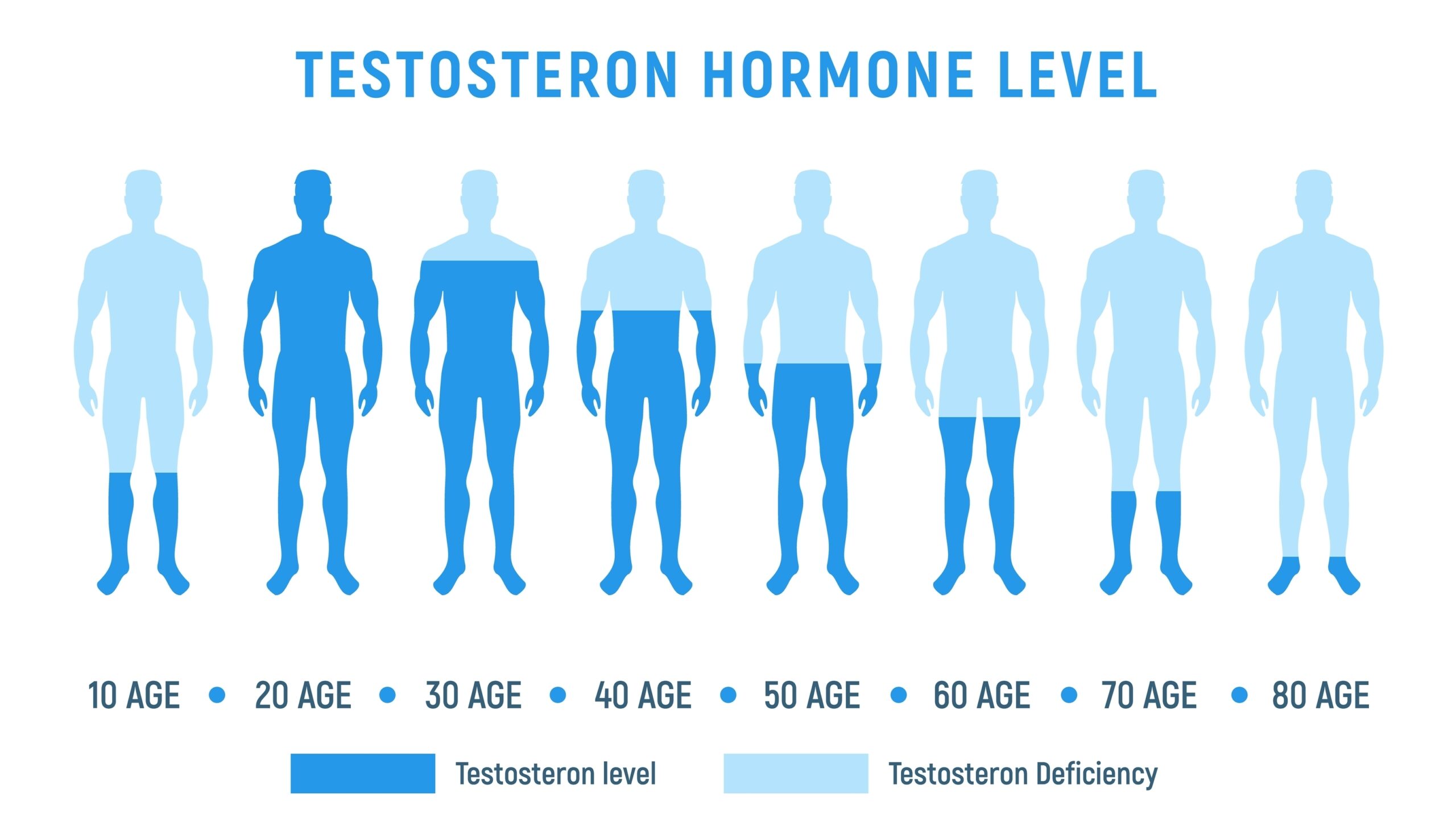Are You a Good Candidate for Low Testosterone Treatment Options?
As an aging man, you may be suffering from lower testosterone and searching for low testosterone treatment options. Testosterone is a crucial hormone, playing a key role in sexual function, physical development, and overall wellbeing. Hypogonadism is when testosterone levels drop, and it can lead to a variety of physical and emotional changes.
While symptoms of hypogonadism affect some men more than others, all patients usually encounter minimal changes in their body and health. Some of the most common physical symptoms include reduced sex drive, erectile dysfunction, and decreased sperm count and fertility. You can also lose muscle mass and strength, gain body fat, suffer bone loss, and get fatigued more easily. Sometimes, breast tissue enlargement will set in, or even loss of body hair or sleep.
Emotional symptoms may also be in play. Depression is a common culprit, as well as irritability and mood swings. Concentration issues and faulty memory seem to haunt men with low testosterone, while self-esteem and low motivation are also related problems.
Believe it or not , testosterone levels naturally decline with age, starting around 30. But it’s not the only cause. Medical conditions can affect testosterone production. This includes pituitary gland disorders, liver or kidney disease, and chronic illnesses such as diabetes and obesity.
Injuries or infections to your testicles can damage the cells that produce testosterone, and sometimes genetic conditions can be a hindrance. Also, certain medications suppress testosterone, such as steroids or pain relievers.
If you’re experiencing low testosterone symptoms, it’s important to see a doctor or pain management specialist immediately. Determining the cause and discussing treatment options should be your top priority.
Low Testosterone Treatment Options: Choose What’s Right
There are several low testosterone treatment options, including replacement therapy, patches, gels, oral tablets, and even implanted pellets. They range from minimally invasive to moderately invasive.
The most common treatment is testosterone replacement therapy, which usually involves injections. These can be administered directly into your buttocks or thigh muscles once a week or twice a month. Then a follow-up injection will be needed once every couple of months after the process kicks in.
What are the benefits of injections? They are highly effective, precise, and relatively cost effective. However, it’s not uncommon to feel some pain at the injection site.
Patches are another option. These are worn daily on your upper arm, abdomen, or back, slowly releasing testosterone through the skin. They are typically worn for 24 hours before needing to be replaced. With patches, the hormone you need slowly releases through your skin and proves to be a convenient and comfortable source of steady testosterone. Just know that your skin may get irritated.
Applied daily to your upper arms, shoulders or abdomen, topical gels are another option. Testosterone is taken in through your skin through relatively quick absorption. Although it’s a little messy and can cause irritation to some, many patients enjoy the convenience.
Another option comes in tablet form, usually called “buccal tablets.” These single-dose tablets are placed between your gum and cheek. They dissolve through the lining of your mouth and release testosterone into the bloodstream. They are discreet and not invasive, although some patients may find the oral placement is uncomfortable and irritable.
Lastly, some men choose to implant pellets under their skin every three to six months, which slowly release testosterone. They last a long time and provide consistency, but they require a minor surgical procedure for insertion and removal.
Research, Treatment Effects, Considerations, and Alternative Issues
Without a prescription, some low testosterone treatment options are available online. These drugs, however, should be taken under the guidance and approval of a doctor.
Researchers have found that many online platforms are not providing testosterone therapy in accordance with American Urological Association and Endocrine Society guidelines. “Using a secret shopper, they found that the platforms offered therapy to men who didn’t meet the guidelines, and they didn’t mention the risks or benefits of testosterone therapy,” states an article in Men’s Health. “Working with a doctor ensures that you’re prescribed testosterone only when you need it and that you’re taking the right dose. Then, they can work with you to make sure your testosterone levels respond appropriately. They like to recheck everything every six months to make sure you’re not having any negative side effects.”
Symptoms can improve within a few weeks to a month after starting testosterone replacement therapy. There are both positive and negative side effects:
- Your sex drive jumps.
- It’s easier to build muscle.
- Your energy levels can soar.
- Your mood can improve.
- It’s likely to affect your fertility.
- Your feet and ankles may swell.
- Your skin type may change.
- Your breasts may enlarge.
Sometimes, patients find they need to treat an underlying medical condition. These can include a pituitary gland dysfunction, hypothalamic disorder, testicular damage, chronic illness, or genetic condition. Treating the underlying condition often aids in restoring levels to normal.
In other cases, different therapies may be used in conjunction with conventional low testosterone treatment options. For instance, clomiphene citrate can stimulate the pituitary gland to produce more testosterone. Also, human chorionic gonadotropin can help your testicles start producing testosterone.
Don’t forget to modify your lifestyle. Maintain a healthy weight, regularly exercise, get adequate sleep, manage your stress levels, and eat more fruits and vegetables.
Diagnosis and Testing for Low Testosterone Treatment Options
Your individual needs, preferences, and underlying causes of low testosterone will determine your low testosterone treatment options. Always consult a pain management specialist or doctor to figure out the best course of minimally invasive solution.
Remember, the purpose of testosterone therapy is to reverse the effects of hypogonadism. Symptoms of low testosterone are not experienced by all men with low testosterone. In fact, many men do not suffer from any symptoms or may only have a few.
To get a definitive diagnosis and rule out other potential causes of symptoms, it’s always best to visit the experts. Depending on the cause of your low testosterone, your treatment will vary.
To determine if you’re a good candidate for therapy, doctors will test your testosterone levels. They usually take two blood tests in the morning on different days. Low testosterone is considered to be anything under 300 nanograms per deciliter. Your health specialist will take into account any symptoms, such as low libido, fatigue, or just feeling tired and out of commission.
Also know there are my voices online saying a variety of things on both sides of the treatment discussion. One study came out saying testosterone therapy does not increase the risk for serious heart problems as some experts once feared.
“This is the trial we’ve been waiting for,” said one of the researchers in the study. “This has provided the closest thing we have to a definitive answer about cardiovascular risk and testosterone therapy.” It said the finding comes nearly a decade after the Food and Drug Administration demanded that drugmakers study the potential cardiovascular effects of therapy.
The right treatment for you depends on your personal preferences, individual circumstances, and insurance coverage. Make sure you discuss all options with the experts before moving forward.
Wellness and Pain Can Help
A range of low testosterone treatment options are available at Wellness and Pain. We offer conservative treatments, routine visits, and minimally invasive quick-recovery procedures to keep you free of problems by providing lifestyle education and home care advice to help you avoid and manage issues. We help in quickly relieving your inhibiting lifestyle conditions when complications arise.
At Wellness and Pain, we personalize patient care plans based on each patient’s condition and unique circumstances. We help to improve wellness, increase mobility, relieve pain, and enhance your mental space and overall health.











